Sep, 2023

Our previous studies identified a population of stem cell-like proliferating myeloid cells within inflamed tissues that could serve as a reservoir for tissue macrophages to adopt different activation states depending on the microenvironment. By lineage-tracing cells derived from CX3CR1+ precursors in mice during infection and profiling by single-cell RNA sequencing, in this study, we identify a cluster of BIRC5+ myeloid cells that expanded in the liver during chronic infection with either the parasite Schistosoma mansoni or the bacterial pathogen Staphylococcus aureus. In the absence of tissue-damaging toxins, S. aureus infection does not elicit these BIRC5+ cells. Moreover, deletion of BIRC5 from CX3CR1-expressing cells results in improved survival during S. aureus infection. Hence the combination of single-cell RNA sequencing and genetic fate-mapping CX3CR1+ cells revealed a toxin-dependent pathogenic role for BIRC5 in myeloid cells during S. aureus infection.